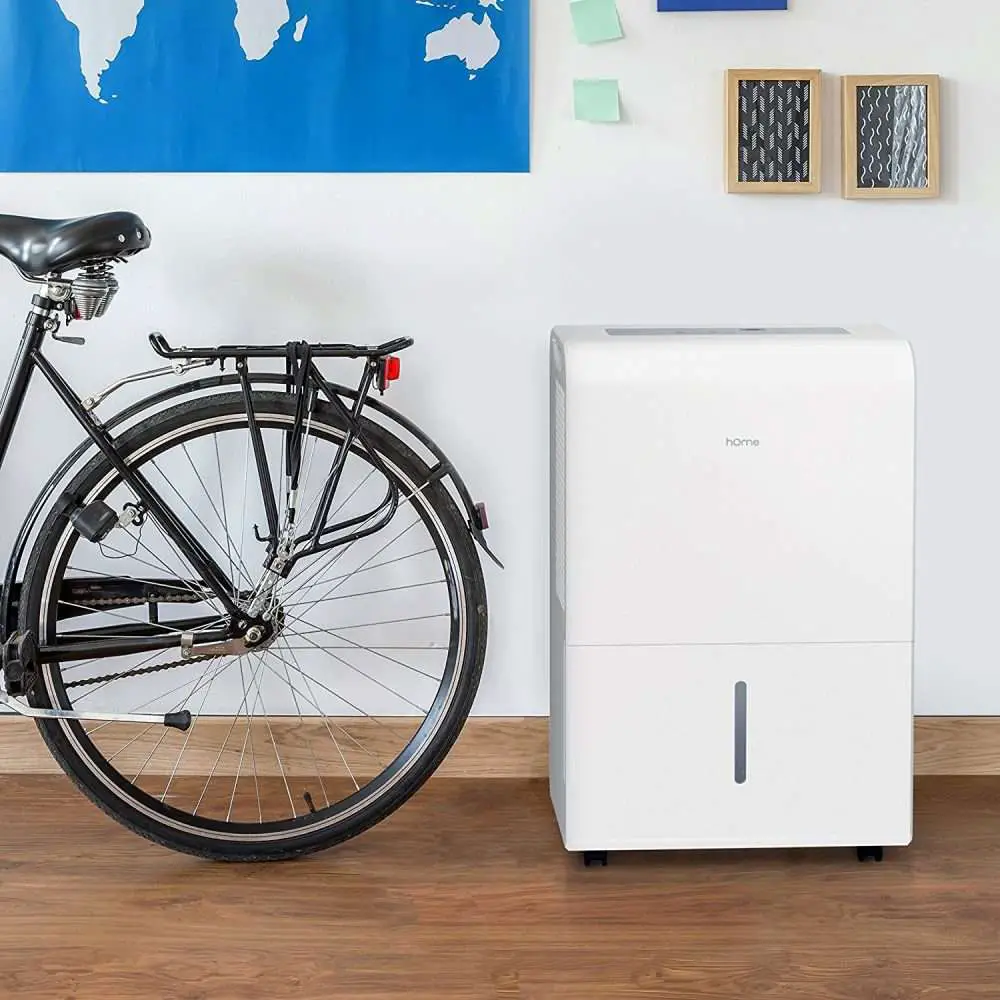Are you shopping for a new dehumidifier? Are you confused over which dehumidifier is the best for your home? Then look no further, as we have tested the best dehumidifiers available to buy in 2021 and have simplified the entire buying process.
Buying one of the best dehumidifiers available will improve the air quality of your entire home. You will be rid of the mold, mildew, allergens, algae and any unpleasant and heavy odors as well as the excess moisture that plague many homes. This is great for storage spaces which are at risk of damp like attics and garages, as well as your living room. Even crawl spaces can be dehumidified which we've covered in our best crawl space dehumidifiers guide.
To help you make an informed decision, we’ve produced several dehumidifier reviews. In this review, we’ve tested and listed the 5 best dehumidifiers on the market, in our opinion. We’ve categorized them by their size so that you have an option for every situation. If you want to see more great options for a specific size category, we have other reviews for every popular size of dehumidifier which we've linked to below.
If you just want to know what the best dehumidifier is, it's the Frigidaire FFAD5033W1.
Top Rated Dehumidifier Reviews For 2021
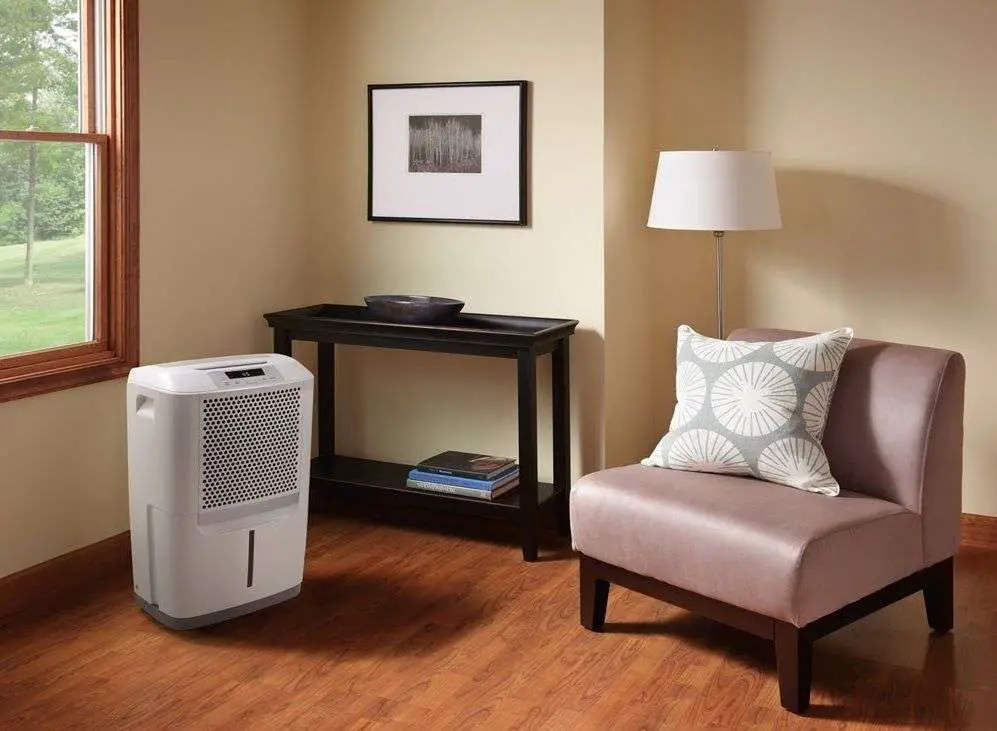
If you don’t know exactly what size of dehumidifier you need, that’s probably where we should start:
The size of a dehumidifier is categorized by how many pints of water it can draw from the air within a 24 hour time period (pints per day). 70 pint dehumidifiers draw 70 pints of moisture per day, while 30 pint dehumidifiers draw 30 pints. 1 pint is equal to 0.125 gallons and 0.47 liters.
In terms of how many pints correspond to how many square foot (sq ft) of physical space, this is a bit trickier to calculate since the level of moisture in the air can vary considerably. Even the best dehumidifier for a bathroom has to work harder than one in the kitchen for example.
Generally speaking, this is how pints and footage correlate:
- The best 30 pint dehumidifiers are suitable for 300 – 400 square feet of space, depending on the moisture levels.
- The best 40 pint dehumidifiers are suitable for 300 – 500 square feet of space, depending on the moisture levels.
- The best 50 pint dehumidifiers are suitable for 500 – 700 square feet of space, depending on the moisture levels.
- The best 60 pint dehumidifiers are suitable for 500 – 1000 square feet of space, depending on the moisture levels.
- The best 70 pint dehumidifiers are suitable for 700 – 1500 square feet of space, depending on the moisture levels.
Once you’ve figured out what size and power dehumidifier you need, you have completed the first step. After that comes a simple choice of quality as well as a choice of what additional features and functions you need and like. Different dehumidifiers have different size water containers, they have different options for continuous drainage, they vary in energy efficiency, use different refrigerants, have different control displays, and so on. A lot of these features are a matter of personal, subjective choice, while others are objectively great to have.
Take a look at the 5 top picks below and you will get an idea of which is the best dehumidifier for 2021 on the market right now. If any product catches your eye – great, we’ll be happy to have helped! If you want more options, check out our other product lists and reviews as well. We regularly update our tests so be sure to check back frequently throughout 2021 to check out our newest top rated dehumidifiers.
Our Rankings & Recommendations
Frigidaire FFAD2233W1 30 Pint Dehumidifier
Frigidaire make a start to our list with their FFAD2233W1 Energy Star awarded portable dehumidifier. This new model has a great removable water bucket that will hold 16 pints of water. This model also has an adjustable percent humidity range that goes from 30% to 90% of relative humidity via the built in humidistat.
There’s also an auto shutoff function that stops the dehumidifier when the water container is full, an auto reset function in case of a power outage, and an auto defrost function to protect against ice build-up on the inside. There are two additional drainage options - manual or continuous drain and there is an included drain hose too.
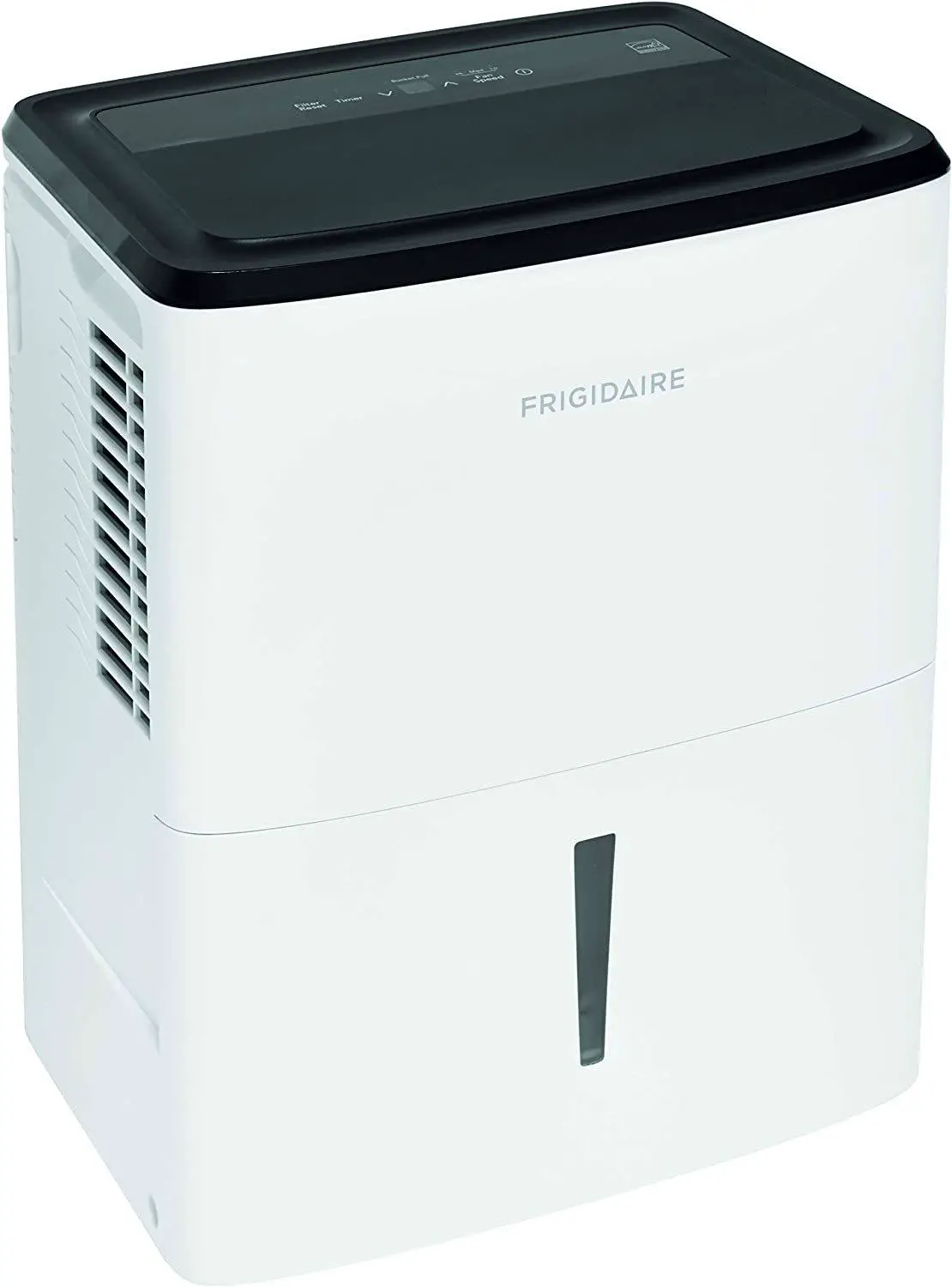
We've said it before and we'll say it again. Frigidaire are a top dehumidifier brand and make some of the greatest dehumidifiers you will come across. Their products are well made and offer a good blend of price and performance.
This 22 pint model (equivalent to the old 30 pint standard) replaces the old 30 pint version and is just as powerful while being more energy efficient. A great option for every homeowner.
Vremi 30 Pint Dehumidifier
The 30 pint dehumidifier we have for you here is a great model from Vremi. This model operates with ease at low temperatures, making it a great choice for your basement or garage, as long as the room temperature there doesn't fall below 40°F. That isn’t the only reason you should buy it, however, since it operates very quietly and is almost certain not to disturb you at home either.
The maximum power consumption is 580W / 3.8A and the air flow is measured at 245 m3/h or 144 CFM. As a result, this model is a very efficient machine that won’t let you down. It also has a 2 in 1 silver-coated washable pre-filter combo and 2 fan speeds. This model is small and light, which, together with its useful castor wheels and handles makes it easy to move.
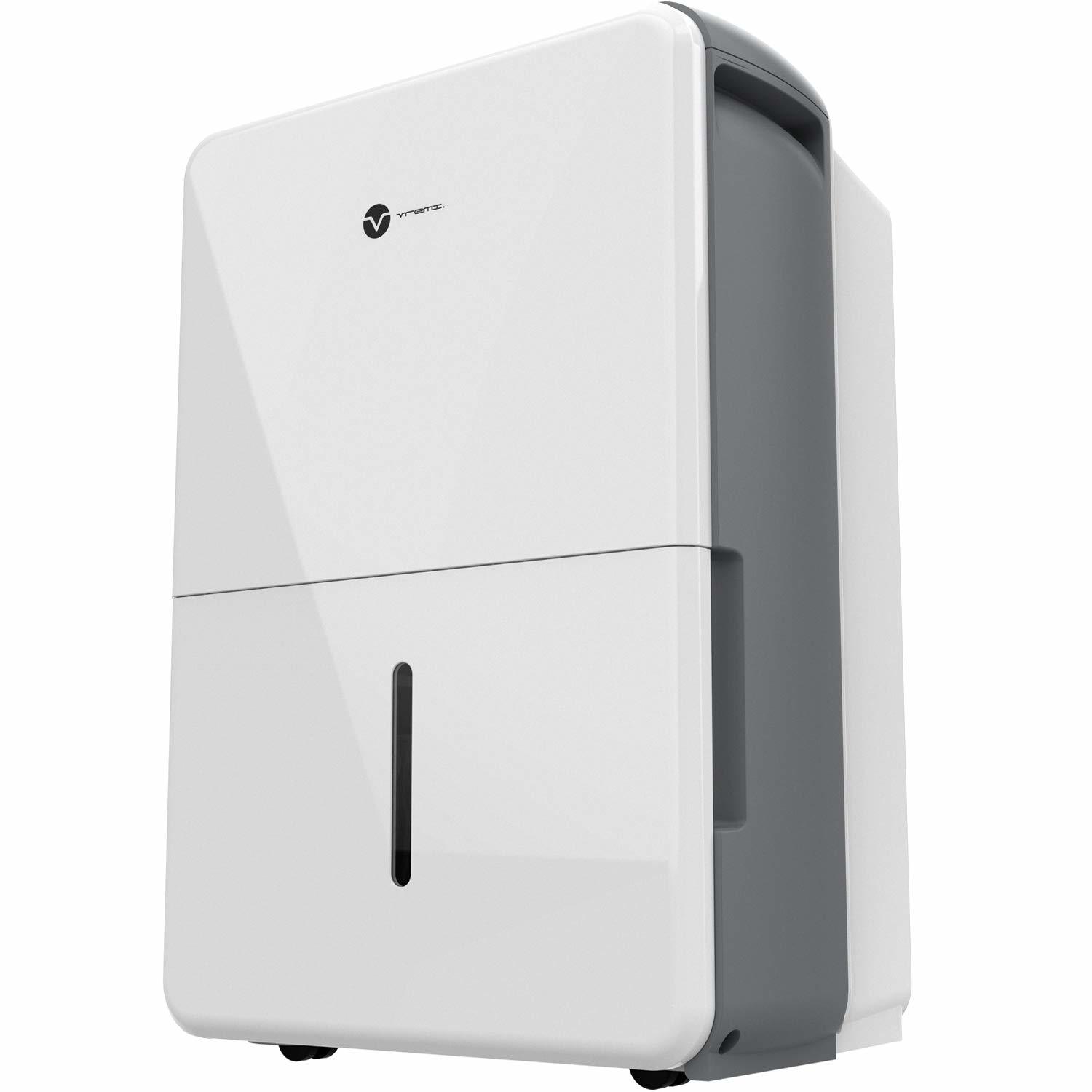
The water reservoir on this model is a little more fiddly than it needs to be but this minor shortcoming can be overcome. There are drain holes on the unit which allow you to insert a drain hose if preferable.
Here are some of the pros and cons of the Vremi 30 Pint Dehumidifier:
hOmeLabs HME020006N 50 Pint Dehumidifier
Another fantastic entry on our list is hOmeLabs and their HME020006N 50 pint model. This dehumidification device is a highly effective and efficient product. Not only that, but it is also quieter than most other dehumidifiers, and is perfectly suitable for your living space.
This model also has a very user friendly design and is quite easy to move around, even though it isn’t actually as light as other similar dehumidifiers of the same power class. As far as the electronic display goes, it is simple and a joy to use. It has an auto restart, an auto shutoff and an auto defrost function. These make sure that the dehumidifier always works when you want it to and you don’t need to worry about internal freezing, the water bucket overflowing or it needing to be restarted after a power outage.
Just as with any hOmeLabs dehumidifier, there is also a water level indicator that will help you manage the water tank without a problem. The fact that the water tank is very easy to operate is a great plus as well. Of course, there is also the continuous drainage option for when you don’t want to bother with emptying the water bucket.
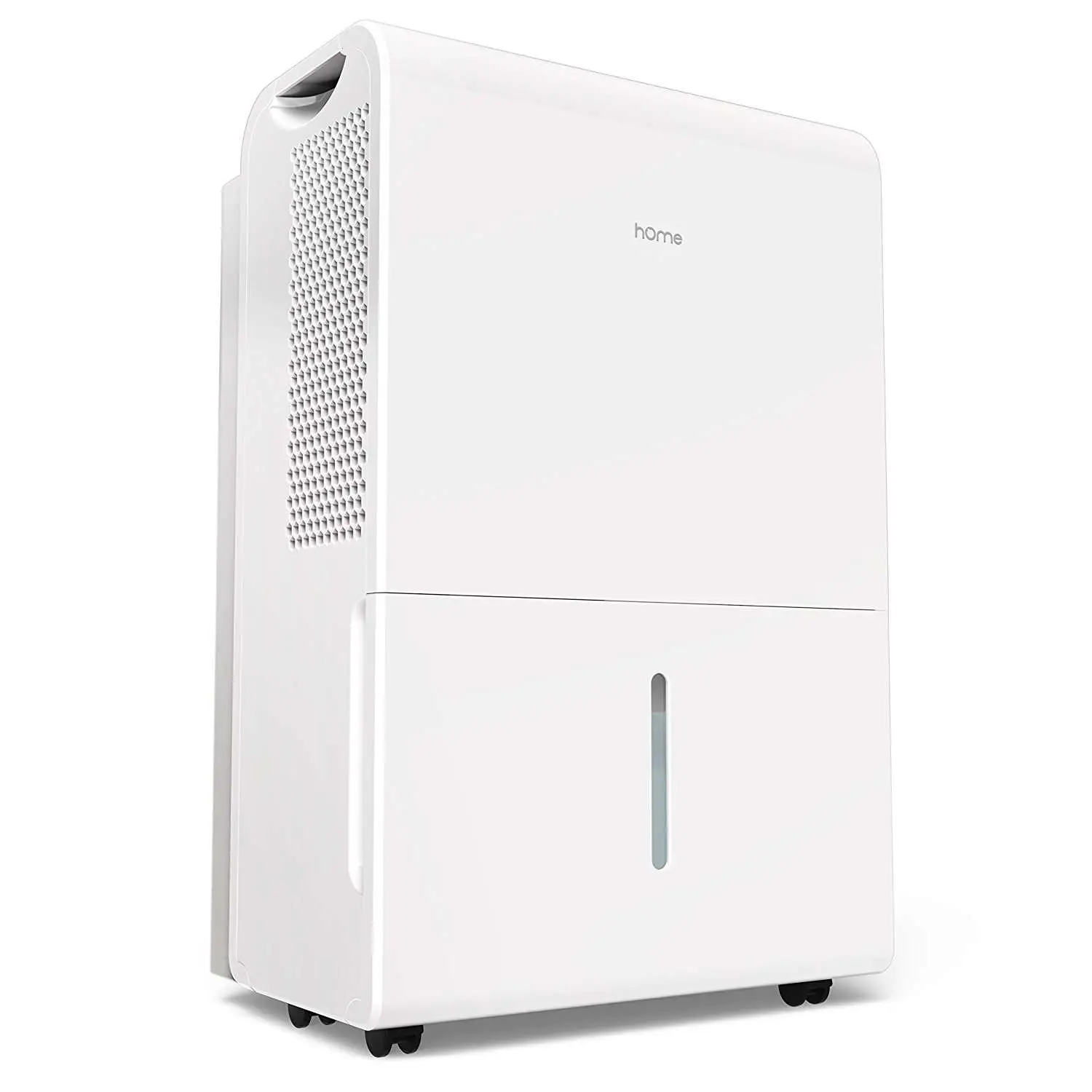
Product Highlights
TOSOT 70 Pint Dehumidifier
Tosot's 70 pint dehumidifier model is a great alternative to the Frigidaire dehumidifier. It is equipped with an electronic control panel, a digital read out and a lot of convenient features.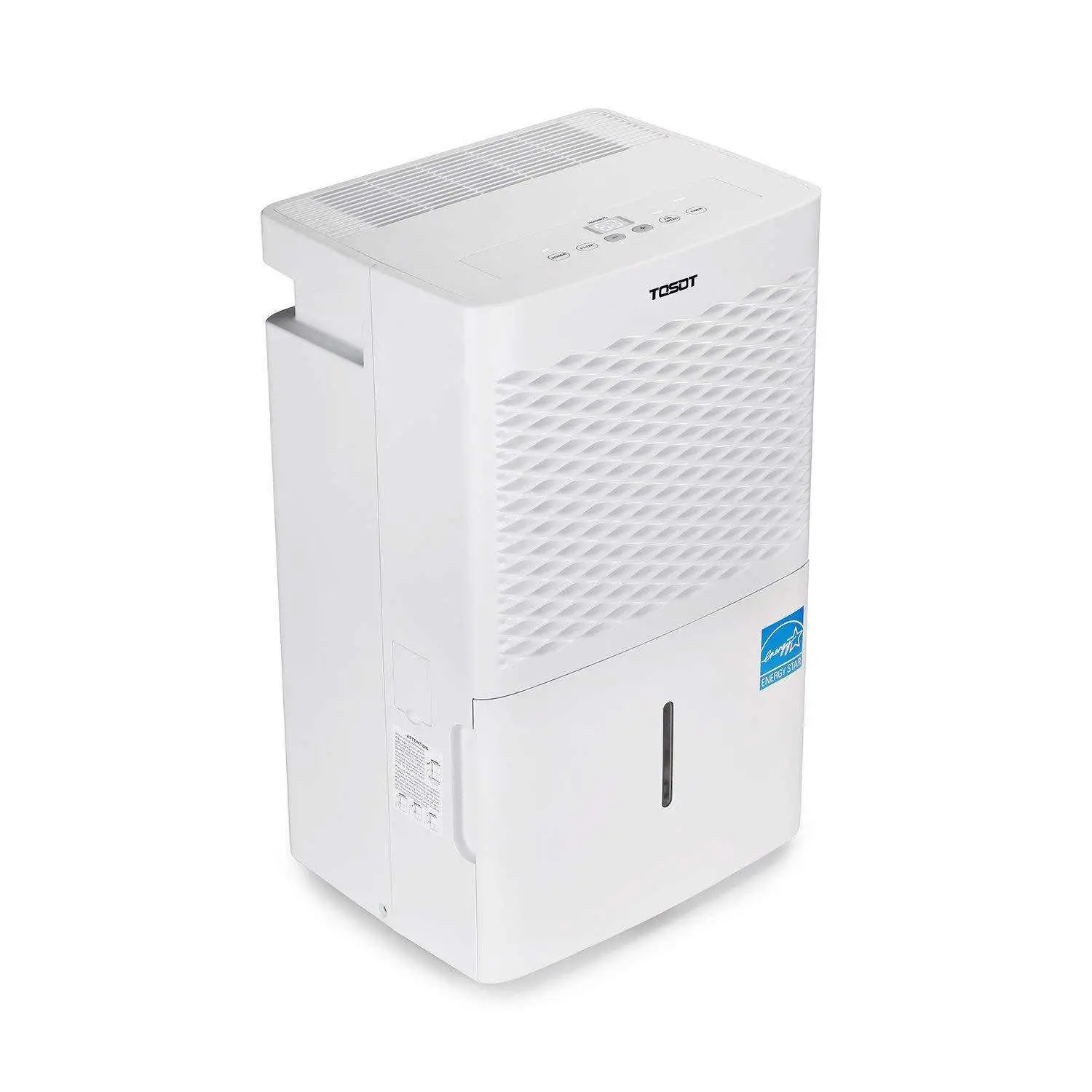
Here are some of the pros and cons of this model:
Frigidaire FFAD7033R1 70 Pint Dehumidifier
Frigidaire make another appearance here too, to bring our list to a close. Their powerful 70 pint dehumidifier (Frigidaire FFAD7033R1) is something truly special and will easily rid your home of any bacteria, mold and mildew, allergens, odors and unwanted moisture from the air which could cause damp. The 70 pint Frigidaire also has a very user-friendly electronic display and a digital humidity level readout.
Operating in low temperature is not a problem for this model as it is very comfortable working at temperatures as low as 41degrees Fahrenheit which are detected through the smart thermostat. This makes it great for any unheated spaces such as a cellar, a shed, an attic or a storage space, as well as for your house. For such a powerful model, it is not too heavy and it’s easily movable.
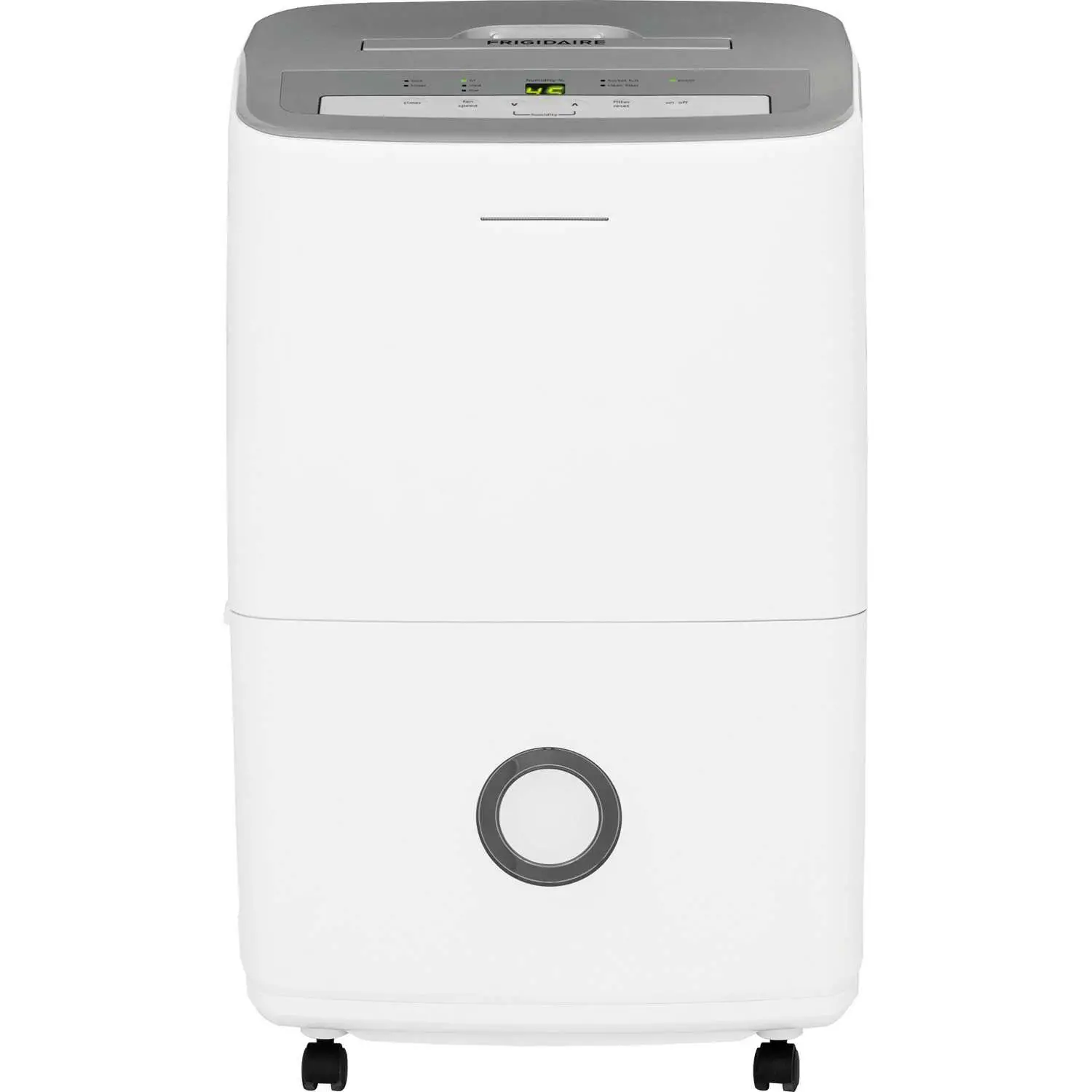
This size category (70 pint models) is the largest that most people need, even for the most spacious of environments. What better dehumidification appliance to use within that environment than the best model of this size that money can buy. The Frigidaire FFAD7033R1 truly is a top dehumidifier.
Dehumidifier Buying Guide
Buying a dehumidifier should be a straightforward task but we often receive requests for assistance from buyers who are struggling to figure out exactly what it is they require from their new dehumidifier other than humidity reduction and moisture removal.
This section is designed to clear up much of the confusion that shoppers have - and in conjunction with our earlier dehumidifier recommendations – should be sufficient for you to feel confident in purchasing the perfect dehumidifier for combating humid air whether in the summer or winter.
Types Of Dehumidifier Available
Not only do dehumidifiers come in a variety of shapes and sizes, they also utilize a variety of different technology types to dehumidify the air in your home. Here you'll learn how these dehumidifiers work.
Compressor Dehumidifiers
The most common type of home dehumidifier available and the one we've tested in this dehumidifier guide is the compressor variety.
They utilize compressed refrigerant to cool metal evaporator coils which are designed to strip moisture from the air that passes through the machine.
Due to the energy efficiency of this technology, they are perfect for home use and the only type of dehumidification appliance that we recommend that you buy.
Desiccant Dehumidifiers
Desiccant technology is utilized in both small and large dehumidifiers, but the term takes on a different meaning depending on the size of the device used.
A desiccant dehumidifier that is suitably sized for home use, uses both a condensor and a heater to remove moisture from the air. Desiccant dehumidifiers are therefore a great choice if you're looking for the best garage dehumidifier. This added heat will help in keeping mold out of your garage.
Even though they can be used at home, this type of dehumidifying device is generally used commercially do to the energy cost of running this type of dehumidifier.
Further reading: Humidifier vs Dehumidifier: What Is The Difference?
Dehumidifier Size
There are several sizes of dehumidifier available which are each designed to perform in a specific type of environment. You will also find that considering your needs for portability is another important aspect of the buying process.
Small Portable Dehumidifiers
Portable dehumidifiers (also known as a mini dehumidifier) are often used within small, enclosed spaces such as closets and cupboards. They are also commonly used within RVs as a substitute for a larger model.
Large Portable Dehumidifiers (Great for Basements)
This is the type of dehumidifier that we have tested in this guide. Each model usually features a set of wheels and a carry handle, making it relatively easy to move from room to room as required. Perfect for use as a dehumidifier for basement humidity reduction in a damp basement.
Whole House Dehumidifiers
This type of full-size dehumidification device is the largest variety available for domestic use. They are usually located within basements or an attic and are designed to dehumidify the air in your entire home through your home's HVAC system (similar to a whole house air conditioner).
Dehumidifier Capacity - What Size Do You Need?
In the preface of this article, we covered the sizing categories (capacities) which are typically attached to each dehumidifier and relate to how much moisture they are able to extract from the air in any 24-hour period.
In this section, we wish to go further and provide you with a recommendation that will cover every eventuality;
“We suggest always purchasing the largest dehumidifier that you can find, regardless of the size of the space that you are trying to dehumidify.”
For most people, this will mean that a 70 pint capacity dehumidifier (the largest consumer size available) is always the best option, whether for a large open plan living room or a small office. And the reason for this is simple; large capacity dehumidifiers are more efficient because they can reduce humidity levels much faster than their smaller equivalents.
If a 70-pint dehumidifier can remove 70 pints of moisture in 24 hours and a 50-pint dehumidifier can remove 50 pints of water in 24 hours – the larger capacity model must be removing water and removing moisture at a much faster rate.
For example - if you had a space which contained a volume of air which held 100 pints of water, the figures below will demonstrate just how quickly each model classification would completely remove the moisture from the air;
70 pint – 34 hours
50 pint – 48 hours
30 pint – 80 hours
CFM Ratings (Cubic Feet Per Minute)
Another important specification for any HVAC appliance designed to reduce humidity is the volume of air that it can process on a per minute basis. A higher CFM rating essentially means that a device can suck air from a greater distance due to the power of its fan than a lower rated dehumidifier.
Larger dehumidifiers usually have a much better CFM rating which is another reason why we suggest purchasing the largest top rated dehumidifier you can, even if it will be used in a smaller space.
Noise Output
Each dehumidifier in our review utilizes a compressor in conjunction with a fan. You therefore need to expect a level of noise output whenever you are using your dehumidifcation appliance.
Each model will differ in how loud they are in operation which we have commented on within each individual review. If you expect to be using your dehumidifier 24 7 or frequently within your living quarters, purchase a quiet model with lower noise levels.
You will also find that adjusting the fan speed setting of each model offers you flexibility in just how much sound is emitted during dehumidifying.
Looking for a quiet dehumidifier? These bedroom dehumidifiers are the quiestest available.
Dehumidifier Energy Efficiency
Tying into our previous point; dehumidifiers run on electricity and are often required to run for extended periods of time. For this reason, a model that gets its job done faster means that it can switch itself off and go into maintenance mode faster, essentially lowering your electricity bills. Always look to buy an energy star dehumidifier if you can.
We always recommend the use of compressor or thermoelectric dehumidifiers for home use rather than desiccant dehumidifiers, simply because they are far more energy efficient.
Reliability And Longevity
Generally speaking, the shorter the duration that a piece of equipment has to operate for, the longer it will last. Mechanical parts wear out over time and will often need to be replaced – but since a larger dehumidifier will run for a shorter amount of time, this should in theory mean it will be able to provide you with reliable service for much longer.
And we think that this theory is backed up by statistics as you will notice that consumer reports and complaints about dehumidifier failures almost always concern smaller capacity models.
Product Warranties
Just as with any electronic device, dehumidifiers can fail and stop working after a period of time. Fortunately, this is relatively uncommon.
The manufacturer of your model is obliged to supply you with a warranty that can be used to prompt a repair under the warranty period.
In addition, the retailer you purchase your dehumidifier from is also legally obliged to provide you with a warranty which can be used to exchange it should it fail during the warranty period.
Drainage Options: Internal Water Tank Or Attached Hose
The last point for consideration concerns just how you intend to use your new dehumidification appliance.
All dehumidifiers need to store or discharge the water that they collect and will shut off automatically if unable to do so.
What this means for you is that if you intend to leave your dehumidifier running for prolonged periods of time, you will need to ensure that you have provided a way for water to drain away, whether into an internal floor drain, a very large bucket or tank, a sink or somewhere outside through a window. Buying a dehumidifier with a built in pump makes this task much easier. If your dehumidifier is supplied without a drainage hose, you can make one yourself with a suitable length of garden hose.
If you only intend to run your dehumidifier for a few hours at a time, the internal water tank will be sufficient for holding collected water. If instead you're looking to use your new model as a commercial dehumidifier, we suggest looking for an auto draining model with a condensate pump to avoid emptying it more frequently than is convenient.
Using A Dehumidifier To Dry Laundry
Many homeowners dry their laundry indoors, especially during the colder, wetter months of the year. The problem is that drying your clothes indoors generates a significant amount of moisture which will increase the water content of the air within your home. The end result is high humidity.
For this reason, the use of a dehumidifying appliance is the perfect way to combat this problem if opening the windows isn't an option or isn't enough to get rid of the additional moisture.
As always, buy the largest model you can as they are capable of faster moisture removal which will dry the air out quicker and prevent mold growth.
Frequently Asked Questions
How Much Does A Dehumidifier Cost To Buy?
As you might expect, dehumidifiers do vary in cost depending on their size and level of specification. A cheap dehumidifier can be purchased from anywhere between $50 and $150 whereas the larger, and much more efficient and powerful models will range from between $150 and $350.
Any dehumidifier that is not going to be placed inside a closet or small bathroom will fall into the more expensive category.
What Type Of Dehumidifier Is Suitable For An Apartment?
People living in an apartment can also benefit from the use of a dehumidifier. Apartments and condo buildings are usually smaller than your average house, but this doesn’t mean that you need a different type of dehumidifier.
Instead, you should take into consideration the average annual relative humidity level which may vary throughout the year as well as the layout (floorplan) of the interior.
Is your apartment open plan or do you have several smaller enclosed spaces and rooms?
If the former, we suggest a 70 pint model. If the latter, you will need to decide whether your dehumidifier will stay in one room or whether you will move it around as required. From there, you can decide whether a 30, 50 or 70 pint model will be more suitable as the best apartment dehumidifier for your home.
Do I Need A Dehumidifier With A Built In Pump?
Another popular question is one surrounding the drainage options for dehumidifiers. You may have noticed that some models ship with what is referred to as a built-in pump, which is essentially a feature that makes removing and disposing of the collected water easier.
If you would rather not rely on the internal water bucket and aren’t able to utilize gravity drainage, a dehumidifier's ability to pump water away may be desirable to you.
Our honest answer is that you would probably be better served with the purchase of a separate condensate pump. These devices allow you to drain water directly into the pump itself if access to a floor drain or sink is difficult.
What Is An Optimal Humidity Setting?
Most homes will benefit from a humidity setting between 35-50% throughout the year. In summer, you will find that you may have to run your dehumidifier for longer to maintain an acceptable level of humidity.
Small spaces will of course dry out faster, even in summer.
Does A Dehumidifier Require Regular Maintenance?
One popular question that many prospective buyers ask is whether or not their new dehumidifier will require regular ongoing maintenance.
We can confirm that other than cleaning the replaceable filter every month in addition to ensuring that the air vents are free from dust and the unit (including the water tank) remains clean, there are no additional maintenance requirements.
Further reading: The Ultimate Dehumidifier Resource
Our Top Picks For The Best Dehumidifier You Can Buy In 2021:
- Best Overall: Frigidaire FFAD5033W1 70 Pint Dehumidifier
- Best Dehumidifier with Pump: TOSOT 70 Pint Dehumidifier
- hOmeLabs HME020006N 50 Pint Dehumidifier
- Vremi 30 Pint Dehumidifier
- Best For Small Rooms: Frigidaire FFAD2233W1 30 Pint Dehumidifier
And there you have them – the 5 best dehumidifiers for 2021 on the market right now in our experience and based on our testing process. If we had to choose a top pick out of the units we reviewed and compared, we are partial towards the Frigidaire brand which has topped several of our other dehumidifier reviews, however, the other products are amazing picks as well and are produced by some of the best dehumidifier brands.
Although not covered in this review, the Keystone KSTAD70B is a great alternative if you are able to find one for sale. This model is now a couple of years old - and even though still a great performer - we haven't recommended it as part of our dehumidifier ratings of 2021 on the grounds of availability.
If you are set on a specific size of dehumidifier, be sure to check out our capacity based dehumidifier review pages for a more in-depth look at the model you require.
Resources:

